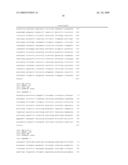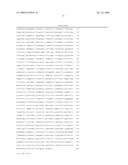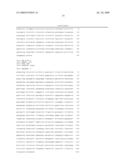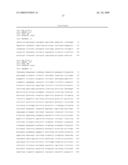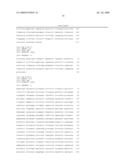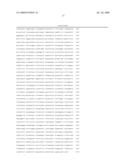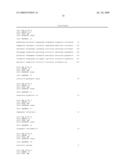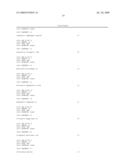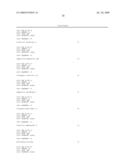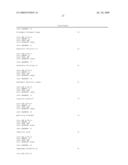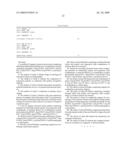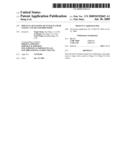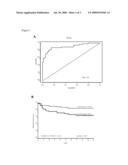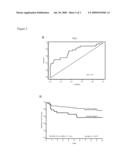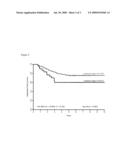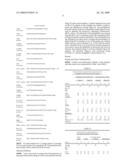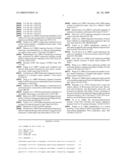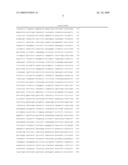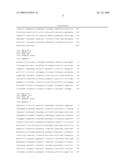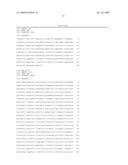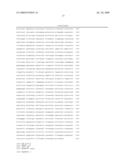Patent application title: MOLECULAR STAGING OF STAGE II AND III COLON CANCER AND PROGNOSIS
Inventors:
Yuqiu Jiang (San Diego, CA, US)
Yi Zhang (San Diego, CA, US)
Yi Zhang (San Diego, CA, US)
Yixin Wang (Basking Ridge, NJ, US)
Yixin Wang (Basking Ridge, NJ, US)
IPC8 Class: AC40B3000FI
USPC Class:
506 7
Class name: Combinatorial chemistry technology: method, library, apparatus method of screening a library
Publication date: 2009-07-30
Patent application number: 20090192045
Claims:
1. A method of staging colorectal cancer status comprising identifying
differential modulation in a combination of genes consisting essentially
of Seq ID NO1, Seq ID NO 3, Seq ID NO 5, Seq ID NO 7, Seq ID NO9, Seq ID
NO11, and Seq ID NO 13.
2. The method of claim 1 wherein Stage II and Stage III colorectal cancer are distinguished.
3. The method of claim 2 wherein the comparison of expression patterns is conducted with pattern recognition methods.
4. The method of claim 3 wherein the pattern recognition methods include the use of a Cox proportional hazards analysis.
5. The method of claim 1 conducted on primary tumor sample.
6. The method of claim 1 wherein if the gene expression pattern of a sample is that of the patter of the Cox proportional hazard analysis indicating Stage II then the colorectal cancer is Stage II colorectal cancer and if it is not then it is Stage III colorectal cancer.
7. A kit for staging colorectal cancer patient comprising materials for detecting isolated nucleic acid sequences, their compliments, or portions thereof of a combination of genes that includes Seq ID NO1, Seq ID NO 3, Seq ID NO 5, Seq ID NO 7, Seq ID NO9, Seq ID NO11, and Seq ID NO 13.
8. The kit of claim 7 wherein the only combination of genes is Seq ID NO1, Seq ID NO 3, Seq ID NO 5, Seq ID NO 7, Seq ID NO9, Seq ID NO11, and Seq ID NO 13 and housekeeping or control genes.
9. The kit of claim 8 further comprising reagents for conducting a microarray analysis.
10. The kit of claim 9 further comprising a medium through which said nucleic acid sequences, their compliments, or portions thereof are assayed.
11. Articles for assessing colorectal cancer status comprising materials for identifying nucleic acid sequences, their complements, or portions thereof of a combination of genes that includes Seq ID NO 1, Seq ID NO 3, Seq ID NO 5, Seq ID NO 7, Seq ID NO9, Seq ID NO11, and Seq ID NO 13.
12. The article of claim 11 wherein the only combination of genes is Seq ID NO1, Seq ID NO 3, Seq ID NO 5, Seq ID NO 7, Seq ID NO9, Seq ID NO11, and Seq ID NO 13 and housekeeping or control genes.
13. The article of claim 12 further comprising reagents for conducting a microarray analysis.
14. The article of claim 13 further comprising a medium through which said nucleic acid sequences, their compliments, or portions thereof are assayed.
15. The article of claim 11 comprising reagents for conducting a PCR reaction wherein said reagents include probes and primers for detecting genes consisting essentially of Seq ID NO1, Seq ID NO 3, Seq ID NO 5, Seq ID NO 7, Seq ID NO9, Seq ID NO11, and Seq ID NO 13 and housekeeping or control genes.
16. The article of claim 15 further comprising instructions for analyzing the results of the use of the kit to stage colorectal cancer.
17. The article of claim 16 wherein the instructions are computer instructions.
18. The article of claim 17 wherein the computer instructions are contained on a magnetic or optical medium.
Description:
BACKGROUND OF THE INVENTION
[0001]Accurate staging of colon cancers not only contributes to disease prognosis prediction, but also to the clinical management and treatment selection of patients. The TNM system based on clinical and pathological features was introduced 1940s, and has gradually evolved and adopted in universal use since the 1980s. Quirke et al. (2007). In these guidelines, adequate lymph node evaluation is critical for appropriate staging of colon cancer. However, due to patient, surgeon, pathologist, and tumor related variables, 63% of colon cancer patients may not receive adequate lymph node evaluation. Baxter et al. (2005).
[0002]Genomic approaches have been successfully applied in identification of cancer classifications and sub-classifications, disease progression prediction, and treatment selection and treatment response prediction. Bhattacharjee et al. (2001); Khan et al. (2001); Sorlie et al. (2003); Agrawal et al. (2002); and Wang et al. (2005). The genetic and epigenetic information provides the opportunities to improve current cancer diagnostic and prognostic accuracy and could be complementary to clinical and pathological parameters. Using microarray analysis, a 23-gene prognostic signature for Stage II colon cancer patients has been developed. Wang et al. (2004). The signature has been further validated in independent samples from multiple clinical sites. Jiang et al. (2008). However, it is still believed that the prognostic value of gene signature may be enhanced through more accurate staging of the tumors.
SUMMARY OF THE INVENTION
[0003]In one aspect of the invention, a diagnostic includes a 7-gene signature for determining whether colon cancer is in Stage II or Stage II.
[0004]In another aspect of the invention, a diagnostic includes reagents for detecting the expression of 7-genes used to distinguish between Stage II and Stage III colon cancer.
[0005]In yet another aspect of the invention, kits for distinguishing between Stage II and Stage III colon cancer and/or providing a prognosis of outcome include reagents for detecting the expression of 7-Marker genes and, optionally, a group of constitutively expressed genes.
BRIEF DESCRIPTION OF THE DRAWINGS
[0006]FIG. 1. ROC and Kaplan-Meier survival analysis of the 7-gene signatures on 137 Stage II and III patients using Affymetrix microarray. A. The ROC curve of the 7-gene signature. B. Kaplan-Meier curve and log rank test of 137 frozen tumor samples using the 7-gene signature. The high and low risk groups differ significantly (P=0.007).
[0007]FIG. 2. ROC and Kaplan-Meier survival analysis of the 7-gene signatures on 123 FPE Stage II and III samples using RTQ-PCR. A. The ROC curve of the 7-gene signature. B. Kaplan-Meier curve and log rank test of 123 FPE samples using the 7-gene signature. The high and low risk groups differ significantly (P=0.0271).
[0008]FIG. 3. Kaplan-Meier survival analysis of the 7-gene signatures on 180 independent FPE Stage II colon cancer samples from 4 different clinic sites using RTQ-PCR.
DETAILED DESCRIPTION OF THE INVENTION
[0009]One of the most important clinical factors for staging of Stage II and Stage III colon cancer is nodal involvement and the clinical guidelines recommend that at least 12 nodes need to be examined for proper staging. However, less than 40% of patients with colon cancer receive adequate lymph node evaluation. Baxter et al. (2005). A 23-gene prognostic signature to predict tumor recurrence in Stage II colon cancer has previously been referred to, in for example, US Patent Publication 20060063157 which is incorporated in its entirety herein by reference. Subsequently, this signature was validated in an independent patient group of 123 Stage II colon cancers using fresh frozen tumor specimens and a group of 110 Stage II patients using formalin-fixed paraffin embedded samples. Jiang et al. (2008). The present invention is directed to more accurate staging.
[0010]A Biomarker is any indicia of an indicated Marker nucleic acid/protein. Nucleic acids can be any known in the art including, without limitation, nuclear, mitochondrial (homeoplasmy, heteroplasmy), viral, bacterial, fungal, mycoplasmal, etc. The indicia can be direct or indirect and measure over- or under-expression of the gene given the physiologic parameters and in comparison to an internal control, placebo, normal tissue or another carcinoma. Biomarkers include, without limitation, nucleic acids and proteins (both over and under-expression and direct and indirect). Using nucleic acids as Biomarkers can include any method known in the art including, without limitation, measuring DNA amplification, deletion, insertion, duplication, RNA, microRNA (miRNA), loss of heterozygosity (LOH), single nucleotide polymorphisms (SNPs, Brookes (1999)), copy number polymorphisms (CNPs) either directly or upon genome amplification, microsatellite DNA, epigenetic changes such as DNA hypo- or hyper-methylation and FISH. Using proteins as Biomarkers includes any method known in the art including, without limitation, measuring amount, activity, modifications such as glycosylation, phosphorylation, ADP-ribosylation, ubiquitination, etc., or immunohistochemistry (IHC) and turnover. Other Biomarkers include imaging, molecular profiling, cell count and apoptosis Markers.
[0011]A Marker gene corresponds to the sequence designated by a SEQ ID NO when it contains that sequence. A gene segment or fragment corresponds to the sequence of such gene when it contains a portion of the referenced sequence or its complement sufficient to distinguish it as being the sequence of the gene. A gene expression product corresponds to such sequence when its RNA, mRNA, or cDNA hybridizes to the composition having such sequence (e.g. a probe) or, in the case of a peptide or protein, it is encoded by such mRNA. A segment or fragment of a gene expression product corresponds to the sequence of such gene or gene expression product when it contains a portion of the referenced gene expression product or its complement sufficient to distinguish it as being the sequence of the gene or gene expression product.
[0012]The inventive methods, compositions, articles, and kits of described and claimed in this specification include one or more Marker genes. "Marker" or "Marker gene" is used throughout this specification to refer to genes and gene expression products that correspond with any gene the over- or under-expression of which is associated with an indication or tissue type.
[0013]Preferred methods for establishing gene expression profiles include determining the amount of RNA that is produced by a gene that can code for a protein or peptide. This is accomplished by reverse transcriptase PCR (RT-PCR), competitive RT-PCR, real time RT-PCR, differential display RT-PCR, Northern Blot analysis and other related tests. While it is possible to conduct these techniques using individual PCR reactions, it is best to amplify complementary DNA (cDNA) or complementary RNA (cRNA) produced from mRNA and analyze it via microarray. A number of different array configurations and methods for their production are known to those of skill in the art and are described in for instance, U.S. Pat. No. 5,445,934; U.S. Pat. No. 5,532,128; U.S. Pat. No. 5,556,752; U.S. Pat. No. 5,242,974; U.S. Pat. No. 5,384,261; U.S. Pat. No. 5,405,783; U.S. Pat. No. 5,412,087; U.S. Pat. No. 5,424,186; U.S. Pat. No. 5,429,807; U.S. Pat. No. 5,436,327; U.S. Pat. No. 5,472,672; U.S. Pat. No. 5,527,681; U.S. Pat. No. 5,529,756; U.S. Pat. No. 5,545,531; U.S. Pat. No. 5,554,501; U.S. Pat. No. 5,561,071; U.S. Pat. No. 5,571,639; U.S. Pat. No. 5,593,839; U.S. Pat. No. 5,599,695; U.S. Pat. No. 5,624,711; U.S. Pat. No. 5,658,734; and U.S. Pat. No. 5,700,637.
[0014]Microarray technology allows for the measurement of the steady-state mRNA level of thousands of genes simultaneously thereby presenting a powerful tool for identifying effects such as the onset, arrest, or modulation of uncontrolled cell proliferation. Two microarray technologies are currently in wide use. The first are cDNA arrays and the second are oligonucleotide arrays. Although differences exist in the construction of these chips, essentially all downstream data analysis and output are the same. The product of these analyses are typically measurements of the intensity of the signal received from a labeled probe used to detect a cDNA sequence from the sample that hybridizes to a nucleic acid sequence at a known location on the microarray. Typically, the intensity of the signal is proportional to the quantity of cDNA, and thus mRNA, expressed in the sample cells. A large number of such techniques are available and useful. Preferred methods for determining gene expression can be found in U.S. Pat. No. 6,271,002; U.S. Pat. No. 6,218,122; U.S. Pat. No. 6,218,114; and U.S. Pat. No. 6,004,755.
[0015]Analysis of the expression levels is conducted by comparing such signal intensities. This is best done by generating a ratio matrix of the expression intensities of genes in a test sample versus those in a control sample. For instance, the gene expression intensities from a diseased tissue can be compared with the expression intensities generated from benign or normal tissue of the same type. A ratio of these expression intensities indicates the fold-change in gene expression between the test and control samples.
[0016]The selection can be based on statistical tests that produce ranked lists related to the evidence of significance for each gene's differential expression between factors related to the tumor's original site of origin. Examples of such tests include ANOVA and Kruskal-Wallis. The rankings can be used as weightings in a model designed to interpret the summation of such weights, up to a cutoff, as the preponderance of evidence in favor of one class over another. Previous evidence as described in the literature may also be used to adjust the weightings.
[0017]A preferred embodiment is to normalize each measurement by identifying a stable control set and scaling this set to zero variance across all samples. This control set is defined as any single endogenous transcript or set of endogenous transcripts affected by systematic error in the assay, and not known to change independently of this error. All Markers are adjusted by the sample specific factor that generates zero variance for any descriptive statistic of the control set, such as mean or median, or for a direct measurement. Alternatively, if the premise of variation of controls related only to systematic error is not true, yet the resulting classification error is less when normalization is performed, the control set will still be used as stated. Non-endogenous spike controls could also be helpful, but are not preferred.
[0018]Gene expression profiles can be displayed in a number of ways. The most common is to arrange raw fluorescence intensities or ratio matrix into a graphical dendogram where columns indicate test samples and rows indicate genes. The data are arranged so genes that have similar expression profiles are proximal to each other. The expression ratio for each gene is visualized as a color. For example, a ratio less than one (down-regulation) appears in the blue portion of the spectrum while a ratio greater than one (up-regulation) appears in the red portion of the spectrum. Commercially available computer software programs are available to display such data including "Genespring" (Silicon Genetics, Inc.) and "Discovery" and "Infer" (Partek, Inc.)
[0019]In the case of measuring protein levels to determine gene expression, any method known in the art is suitable provided it results in adequate specificity and sensitivity. For example, protein levels can be measured by binding to an antibody or antibody fragment specific for the protein and measuring the amount of antibody-bound protein. Antibodies can be labeled by radioactive, fluorescent or other detectable reagents to facilitate detection. Methods of detection include, without limitation, enzyme-linked immunosorbent assay (ELISA) and immunoblot techniques.
[0020]Modulated genes used in the methods of the invention are described in the Examples. The genes that are differentially expressed are either up regulated or down regulated in patients with carcinoma of a particular origin relative to those with carcinomas from different origins. Up regulation and down regulation are relative terms meaning that a detectable difference (beyond the contribution of noise in the system used to measure it) is found in the amount of expression of the genes relative to some baseline. In this case, the baseline is determined based on the algorithm. The genes of interest in the diseased cells are then either up regulated or down regulated relative to the baseline level using the same measurement method. Diseased, in this context, refers to an alteration of the state of a body that interrupts or disturbs, or has the potential to disturb, proper performance of bodily functions as occurs with the uncontrolled proliferation of cells. Someone is diagnosed with a disease when some aspect of that person's genotype or phenotype is consistent with the presence of the disease. However, the act of conducting a diagnosis or prognosis may include the determination of disease/status issues such as determining the likelihood of relapse, type of therapy and therapy monitoring. In therapy monitoring, clinical judgments are made regarding the effect of a given course of therapy by comparing the expression of genes over time to determine whether the gene expression profiles have changed or are changing to patterns more consistent with normal tissue.
[0021]Genes can be grouped so that information obtained about the set of genes in the group provides a sound basis for making a clinically relevant judgment such as a diagnosis, prognosis, or treatment choice. These sets of genes make up the portfolios of the invention. As with most diagnostic Markers, it is often desirable to use the fewest number of Markers sufficient to make a correct medical judgment. This prevents a delay in treatment pending further analysis as well unproductive use of time and resources.
[0022]One method of establishing gene expression portfolios is through the use of optimization algorithms such as the mean variance algorithm widely used in establishing stock portfolios. This method is described in detail in 20030194734. Essentially, the method calls for the establishment of a set of inputs (stocks in financial applications, expression as measured by intensity here) that will optimize the return (e.g., signal that is generated) one receives for using it while minimizing the variability of the return. Many commercial software programs are available to conduct such operations. "Wagner Associates Mean-Variance Optimization Application," referred to as "Wagner Software" throughout this specification, is preferred. This software uses functions from the "Wagner Associates Mean-Variance Optimization Library" to determine an efficient frontier and optimal portfolios in the Markowitz sense is preferred. Markowitz (1952). Use of this type of software requires that microarray data be transformed so that it can be treated as an input in the way stock return and risk measurements are used when the software is used for its intended financial analysis purposes.
[0023]The process of selecting a portfolio can also include the application of heuristic rules. Preferably, such rules are formulated based on biology and an understanding of the technology used to produce clinical results. More preferably, they are applied to output from the optimization method. For example, the mean variance method of portfolio selection can be applied to microarray data for a number of genes differentially expressed in subjects with cancer. Output from the method would be an optimized set of genes that could include some genes that are expressed in peripheral blood as well as in diseased tissue. If samples used in the testing method are obtained from peripheral blood and certain genes differentially expressed in instances of cancer could also be differentially expressed in peripheral blood, then a heuristic rule can be applied in which a portfolio is selected from the efficient frontier excluding those that are differentially expressed in peripheral blood. Of course, the rule can be applied prior to the formation of the efficient frontier by, for example, applying the rule during data pre-selection.
[0024]Other heuristic rules can be applied that are not necessarily related to the biology in question. For example, one can apply a rule that only a prescribed percentage of the portfolio can be represented by a particular gene or group of genes. Commercially available software such as the Wagner Software readily accommodates these types of heuristics. This can be useful, for example, when factors other than accuracy and precision (e.g., anticipated licensing fees) have an impact on the desirability of including one or more genes.
[0025]The gene expression profiles of this invention can also be used in conjunction with other non-genetic diagnostic methods useful in cancer diagnosis, prognosis, or treatment monitoring. For example, in some circumstances it is beneficial to combine the diagnostic power of the gene expression based methods described above with data from conventional Markers such as serum protein Markers (e.g., Cancer Antigen 27.29 ("CA 27.29")). A range of such Markers exists including such analytes as CA 27.29. In one such method, blood is periodically taken from a treated patient and then subjected to an enzyme immunoassay for one of the serum Markers described above. When the concentration of the Marker suggests the return of tumors or failure of therapy, a sample source amenable to gene expression analysis is taken. Where a suspicious mass exists, a fine needle aspirate (FNA) is taken and gene expression profiles of cells taken from the mass are then analyzed as described above. Alternatively, tissue samples may be taken from areas adjacent to the tissue from which a tumor was previously removed. This approach can be particularly useful when other testing produces ambiguous results.
[0026]Methods of isolating nucleic acid and protein are well known in the art. See e.g. U.S. Pat. No. 6,992,182 incorporated by reference herein in its entirety and the discussion of RNA isolation at the Ambion website on the World Wide Web of the Internet, and US 20070054287.
[0027]DNA analysis can be any known in the art including, without limitation, methylation, de-methylation, karyotyping, ploidy (aneuploidy, polyploidy), DNA integrity (assessed through gels or spectrophotometry), translocations, mutations, gene fusions, activation--de-activation, single nucleotide polymorphisms (SNPs), copy number or whole genome amplification to detect genetic makeup. RNA analysis includes any known in the art including, without limitation, q-RT-PCR, miRNA or post-transcription modifications. Protein analysis includes any known in the art including, without limitation, antibody detection, post-translation modifications or turnover. The proteins can be cell surface markers, preferably epithelial, endothelial, viral or cell type. The Biomarker can be related to viral/bacterial infection, insult or antigen expression.
[0028]Kits made according to the invention include formatted assays for determining the gene expression profiles. These can include all or some of the materials needed to conduct the assays such as reagents and instructions and a medium through which Biomarkers are assayed.
[0029]Articles of this invention include representations of the gene expression profiles useful for treating, diagnosing, prognosticating, and otherwise assessing diseases. These profile representations are reduced to a medium that can be automatically read by a machine such as computer readable media (magnetic, optical, and the like). The articles can also include instructions for assessing the gene expression profiles in such media. For example, the articles may comprise a CD ROM having computer instructions for comparing gene expression profiles of the portfolios of genes described above. The articles may also have gene expression profiles digitally recorded therein so that they may be compared with gene expression data from patient samples. Alternatively, the profiles can be recorded in different representational format. A graphical recordation is one such format. Clustering algorithms such as those incorporated in "DISCOVERY" and "INFER" software from Partek, Inc. mentioned above can best assist in the visualization of such data.
[0030]Different types of articles of manufacture according to the invention are media or formatted assays used to reveal gene expression profiles. These can comprise, for example, microarrays in which sequence complements or probes are affixed to a matrix to which the sequences indicative of the genes of interest combine creating a readable determinant of their presence. Alternatively, articles according to the invention can be fashioned into reagent kits for conducting hybridization, amplification, and signal generation indicative of the level of expression of the genes of interest for detecting cancer.
[0031]The following examples are provided to illustrate but not limit the invention.
Example 1
Materials and Methods
Patient Samples
[0032]Frozen tumor specimens from 78 coded Stage II and 59 Stage III colon cancer patients were obtained. Archived primary tumor samples were collected at the time of surgery. The histopathology of each specimen was reviewed on the H&E stained tissue section to confirm diagnosis and tumor content. Tumor content was estimated in percentage by counting nuclei of epithelial tumor cells. Patient eligibility criteria include: colon primary Stage II and III adenocarcinoma, primary treatment is surgery only without adjuvant or neo-adjuvant therapy, at least 70% of tumor cells in the tissue sample, and at least 3 years of follow-up except for patients who developed distant relapse before that time. Post-surgery patient surveillance was carried out according to general practice for colon cancer patients including physical exam, blood counts, liver function tests, serum CEA, and colonoscopy for the patients. Selected patients had abdominal CT scan and chest X-ray. If cancer recurrence was suspected, the patient underwent diagnostic work-up including colonoscopy, chest/abdominal/pelvic CT and MRI for selected patients. Diagnostic biopsy to confirm metastatic lesion was performed in all patients where feasible. Time to recurrence or disease-free time was defined as the time period from the date of surgery to confirmed tumor relapse date for relapsed patients and from the date of surgery to the date of last follow-up for disease-free patients.
[0033]FPE tumor specimens from 85 Stage II and 38 Stage III colon cancer patients were also obtained. There were also 180 Stage II colon cancer FPE specimens acquired separately. The histopathology of each specimen was reviewed to confirm diagnosis and tumor content. Patient eligibility criteria and follow-up procedures were the same as for the selection of the frozen samples.
Microarray Analysis
[0034]All frozen tumor tissues were processed for RNA isolation. Baxter et al. (2005). Biotinylated targets were prepared using published methods (Affymetrix, Santa Clara, Calif.) and hybridized to Affymetrix U133a GeneChips (Affymetrix, Santa Clara, Calif.). Arrays were scanned using the standard Affymetrix protocol. Each probe set was considered a separate gene. Expression values for each gene were calculated using Affymetrix GeneChip® analysis software MAS 5.0 and according to the analysis method described previously. Wang et al. (2004).
RNA Isolation from FPE Samples
[0035]The FPE samples were either formalin-fixed (n=45) or Hollandes-fixed (n=65) FPE tissues. RNA isolation from FPE tissue samples was carried out according to a modified protocol using High Pure RNA Paraffin Kit (Roche Applied Sciences, Indianapolis, Ind.). FPE tissue blocks were sectioned depending on the size of the blocks (6-8 mm=6×10 μm, ≧8 mm=3×10 μm). Sections were de-paraffinized as described in the manufacturer's manual. The tissue pellet was dried in oven at 55° C. for 10 minutes and resuspended in 100 μL of tissue lysis buffer, 16 μL 10% SDS and 80 μL Proteinase K. The sample was vortexed and incubated in a thermomixer set at 400 rpm for 3 hours at 55° C. Subsequent steps of sample processing were performed according the Kit manual. The RNA sample was quantified by OD 260/280 readings using spectrophotometer and diluted to a final concentration of 50 ng/uL. The isolated RNA samples were stored in RNase-free water at -80° C. until use.
RTQ-PCR Analysis
[0036]The gene signature and the housekeeping control genes were evaluated using a one-step multiplex RTQ-PCR assay with the RNA samples isolated from FPE tissues. In order to minimize the variability of RTQ-PCR reaction, three housekeeping control genes including β-actin, HMBS, and RPL13A, were used to normalize the input quantity of RNA. To prevent any contaminating DNA in the samples from amplification, PCR primers or probes for RTQ-PCR assay were designed to span an intron so that the assay would not amplify any residual genomic DNA. One hundred nanograms of total RNA were used for the one-step RTQ-PCR reaction. The reverse transcription was carried out using 40× Multiscribe and RNase inhibitor mix contained in the TaqMan® one-step PCR Master Mix reagents kit (Applied Biosystems, Fresno, Calif.). The cDNA was then subjected to the 2× Master Mix without uracil-N-glycosylase (UNG). PCR amplification was performed on the ABI 7900HT sequence detection system (Applied Biosystems, Frenso, Calif.) using the 384-well block format with 10 μL reaction volume. The concentrations of the primers and the probes were 4 and 2.5 μmol/L, respectively. The reaction mixture was incubated at 48° C. for 30 minutes for the reverse transcription, followed by an Amplitaq® activation step at 95° C. for 10 minutes and then 40 cycles of 95° C. for 15 seconds for denaturing and of 60° C. for 1 minute for annealing and extension. A standard curve was generated from a range of 100 pg to 100 ng of the starting materials, and when the R2 value was >0.99, the cycle threshold (Ct) values were accepted. In addition, all primers and probes were optimized towards the same amplification efficiency according to the manufacturer's protocol. Sequences of the primers and probes for the 7 genes and the 3 housekeeping control genes were as follows, each written in the 5' to 3' direction:
TABLE-US-00001 EP2MA CATTATTCAAGGCCGAGTACAGATG; forward, EP2MA CACGTACACGATGTGTCCCTTCT; reverse, EP2MA FAM-CAGGCGGTGTGCCTGCTGCAT-BHQ. probe, KLF5 CCTGAGGACTCACACTGGTGAA; forward, KLF5 CAGCTCATCCGATCGCG; reverse, KLF5 FAM-CAAGTGTACCTGGGAAGGCTGCGACTG-BHQ. probe, CAPG CGCAGCTCTGTATAAGGTCTCTGA; forward, CAPG GATATCAGCAGTTCAAGGGCAA; reverse, CAPG FAM-AACCTGACCAAGGTGGCTGACTCCAG-BHQ. probe, LILRB3 AGATGGACACTGAGGCTGCTG; forward, LILRB3 CTTCCGTCTAAGGGTCAAGCTG; reverse, LILRB3 FAM-CCCAGGATGTGACCTACGCCCAG-BHQ. probe, LAT CTCCCACCGGACGCCATC; forward, LAT CCTCGTTCTCGTAGCTCGCCA; reverse, LAT probe, FAM-CGGGATTCTGATGGTGCCAACAGT-BHQ-1-TT. CHC1 TTTGTGGTGCCTATTTCACCTTT; forward, CHC1 CGGAGTTCCAAGCTGATGGTA; reverse, CHC1 probe, FAM-CCACGTGTACGGCTTCGGCCTC-BHQ. YWHAH CCTGTCTCTTGGGAAGCAGTTT; forward, YWHAH GCTCCTGTGGGCTCAAAG; reverse, YWHAH FAM-ATCATGGGCATTGCTGGACTGATGG-BHQ. probe, β-actin AAGCCACCCCACTTCTCTCTAA; forward, β-actin AATGCTATCACCTCCCCTGTGT; reverse, β-actin FAM-AGAATGGCCCAGTCCTCTCCCAAGTC-BHQ. probe, HMBS CCTGCCCACTGTGCTTCCT; forward, HMBS GGTTTTCCCGCTTGCAGAT; reverse, HMBS probe, FAM-CTGGCTTCACCATCG-BHQ. RPL13A CGGAAGAAGAAACAGCTCATGA; forward, RPL13A CCTCTGTGTATTTGTCAATTTTCTTCTC; reverse, RPL13A FAM-CGGAAACAGGCCGAGAA-BHQ. probe,
[0037]For each sample ΔCt=Ct (target gene)-Ct (average of four control genes) was calculated. ΔCt normalization has been widely used in clinical RTQ-PCR assay.
Statistical Methods
[0038]t tests were used to compare the discrimination of each gene between the Stage II colon cancer patients and the Stage III colon cancer patients. Logistic regression was used on the CCF patients as the training set to build a model to assess the likelihood of being Stage III. The probabilities from the logistic model for each patients being Stage III were used to generate the Receiver's Operating Characteristic (ROC) curves. The threshold of the probabilities was chosen from the ROC curve to produce at least 90% specificity (90% of Stage II patients correctly identified). The model built from the training set was then used to compute the probabilities of being Stage III for patients of one of the testing sets. Kaplan Meier survival curves (Kaplan et al. (1958) and the hazard ratios calculated from Cox proportional hazards regression were used to assess the difference in recurrence free survival between the predicted Stage II and the predicted Stage III patients. All statistical analyses were performed using S-Plus® 6-1 software (Insightful, Fairfax Station, Va.).
Results
Patient and Tumor Characteristics
[0039]Clinical and pathological features of the patients and their tumors are summarized in Table 1 and Table 2.
TABLE-US-00002 TABLE 1 Patient and tumor characteristics Cleveland Clinic Foundation Fresh Frozen and FPE samples Cleveland Clinic Fresh Frozen Cleveland Clinic FFPE Stage II Stage III Stage II Stage III Factor # % # % # % # % Average 70 67 69 65 age (yr) Sex Male 40 51 32 54 46 54 20 53 Female 38 49 27 46 39 46 18 47 T Stage T1 0 0 10 17 0 0 4 10 T2 68 87 35 59 75 88 25 66 T3 10 13 14 24 10 12 9 24 Grade Good 7 9 3 5 9 10 1 3 Moderate 57 73 40 68 61 72 26 68 Poor 14 18 16 27 15 18 11 29 Metastasis Yes 7 9 22 37 14 16 14 37 No 71 91 37 63 71 84 24 63 Median # LN 28 (2-165) 31 (2-333) 29 (2-165) 38 (8-333) examined
TABLE-US-00003 TABLE 2 Patient and tumor characteristics of 180 validation samples (FPE tissues) Mayo San Diego Sharp Clinic Oridis Hospital Proteogenex Factor # % # % # % # % Average 73 68 80 64 age (yr) Sex Male 26 38 28 55 12 48 14 29 Female 43 62 23 45 13 52 35 71 T Stage T2 0 0 0 0 0 0 2 4 T3 66 96 43 84 22 88 40 82 T4 3 4 8 16 3 12 7 14 Grade Good 0 0 1 2 1 4 5 10 Moderate 34 49 36 71 23 92 8 16 Poor 28 41 14 27 1 4 3 6 Unknown 7 10 0 0 0 0 33 68 Metastasis Yes 14 20 18 35 4 16 15 31 No 55 80 33 65 21 84 34 69 Median # LN 13 (3-32) 19 (6-72) 29 (2-165) 10 (2-38) examined
[0040]All patients had information on age, gender, TNM stage, number of lymph nodes examined, grade, and tumor location. All the patients had sporadic colon cancer. Rectal cancer patient was excluded from the study. TNM staging was performed according to AJCC 6th edition guidelines. Histological grade or differentiation status was also reported by each clinical site. The number of lymph nodes examined varied among the sites because the samples came from the archived collections at different time periods. The patients were treated by surgery only and none of the patients received neo-adjuvant or adjuvant treatment. A minimum of 3 years of follow-up data was available for all the patients in the study with the exception of those with relapse or death in less than 3 years. The statistical analysis suggested that the tumor characteristics did not differ significantly between the relapse and the non-relapse patients. Analysis of the Gene Signature in the Fresh Frozen Samples.
[0041]In the patient sample group of an earlier study (Wang et al. (2004)), two subgroups were detected of tumors representing well- and poorly-differentiated tumors, respectively. Cadherin 17 gene expression was used to stratify the Stage II tumors into the two subgroups and the prognostic gene signature was designed to include classifiers for subgroup I (7 genes) and subgroup II (15 genes). In the present study, it was found that subgroup II (undetectable Cadherin 17) only accounted for 1 of the 78 Stage II tumors (1.3%) and 1 of the 59 Stage III tumors (1.7%). Therefore, an improved gene signature was formulated that includes only the 7 genes for subgroup I in the algorithm for current studies. The 7 genes are listed in Table 3 as follows with GenBank ID and Affymetrix U133a chip ID.
TABLE-US-00004 TABLE 3 Gene Seq ID No LILRB3 1 YWHAH 3 RCC1 5 KLF5 7 CAPG 9 LAT 11 EPM2A 13
[0042]To assess the staging property of the 7-gene signature, we first used t test to compare the discrimination power of the 7 genes for differentiating the clinically defined Stage II and III patients. Then logistic regression was applied to the 137 samples to build a model to evaluate the likelihood of each patient being Stage III or Stage II. The parameter that was used to assess the performance of the 7-gene signature as a stage predictor was the area under the curve (AUC) of Receiver's Operating Characteristic (ROC) analysis. As shown in FIG. 1A, the signature gave an AUC value of 0.9.
[0043]The Kaplan-Meier analysis produced survival curves for the predicted Stage II and III patients (FIG. 1B). Clearly, the predicted Stage II and III patients segregated into two distinct clusters of patients with good prognosis (predicted Stage II patients) and poor prognosis (predicted Stage III patients). In the univariate Cox proportional hazards regression model, the estimated relative risk for tumor recurrence was 2.7 (95% CI, 1.3-5.5, P=0.007). Analysis of the Gene Signature in the FPE Samples
[0044]In order to demonstrate the staging value of the 7-gene signature in clinically relevant samples, RTQ-PCR assay was developed and performed first on 123 FPE samples from Stage II and III colon tumors. Since the RTQ-PCR assay is entirely different from the microarray analysis, in terms of the sample type and assay platform, the Stage discrimination power of the 7 genes were reevaluated by t test. A model to evaluate the likelihood of each patient being Stage III or Stage II was built again using logistic regression on these 123-patient RTQ-PCR dataset. First, the ROC curve was evaluated (FIG. 2A). The 7-gene predictor gave an AUC value of 0.77.
[0045]The Kaplan-Meier analysis and the log rank test both showed a significant difference in the time to recurrence between the group with predicted Stage III cancer and the group with predicted Stage II cancer (HR 2.4, 95% CI 1.1-5.2; P=0.02) (FIG. 2B).
Evaluation of an Independent Test Set from 4 Different Clinical Sites
[0046]The 7-gene signature has been tested on clinically defined Stage II and III colon cancers and it was demonstrated that the signature has the ability to differentiate these two classes with fresh frozen specimen on microarray platform and with FPE specimen on RTQ-PCR platform. To test whether the predefined 7-gene signature would be able to differentiate the good prognosis patients from the poor prognosis patients for the clinically defined Stage II colon cancers, 180 test-set samples were used to assess the 7-gene utility. By applying the predefined model and algorithm obtained from the 123 Stage II and III sample set, 150 of the 180 clinical Stage II patients were classified as predicted Stage II cancers and 30 clinical Stage II patients were classified as predicted Stage III cancers. The Kaplan-Meier analysis and the log rank test both showed a significant difference in the time to recurrence between the group with predicted Stage III cancer and the group with predicted Stage II cancer (HR 2.0, 95% CI 1.0-3.6; P=0.05), as shown in FIG. 3.
REFERENCES CITED
[0047]20030194734 [0048]20070054287 [0049]U.S. Pat. No. 5,424,186 [0050]U.S. Pat. No. 5,529,756 [0051]U.S. Pat. No. 5,532,128 [0052]U.S. Pat. No. 5,545,531 [0053]U.S. Pat. No. 5,556,752 [0054]U.S. Pat. No. 5,561,071 [0055]Agrawal et al. (2002) Osteopontin identified as lead marker of colon cancer progression, using pooled sample expression profiling J Natl Cancer Inst 94:513-521 [0056]Baxter et al. (2005) Lymph node evaluation in colorectal cancer patients: a population-based study J Natl Cancer Inst 97:219-25 [0057]Benson et al. (2004) American Society of Clinical Oncology recommendations on adjuvant chemotherapy for stage II colon cancer J Clin Oncol 22:3408-19 [0058]Bhattacharjee et al. (2001) Classification of human lung carcinomas by mRNA expression profiling reveals distinct adenocarcinoma subclasses Proc Natl Acad Sci USA 98:13790-13795 [0059]Brookes (1999) The essence of SNPs Gene 234:177-186 [0060]Chang et al. (2007) Lymph node evaluation and survival after curative resection of colon cancer: systematic review J Natl Cancer Inst 99:433-41 [0061]Eschrich et al. (2005) Molecular staging for survival prediction of colorectal cancer patients J Clin Oncol 23:3526-35 [0062]Jiang et al. (2008) Molecular signature classifies Stage II and III colon cancer and predicts tumor recurrence Submitted to J Mol Diag [0063]Johnson et al. (2002) Adequacy of nodal harvest in colorectal cancer: a consecutive cohort study J Gastrointest Surg 6:883-88 [0064]Kaplan et al. (1958) Non-parametric estimation of incomplete observations J Am Stat Assoc 53:457-481 [0065]Khan et al. (2001) Classification and diagnostic prediction of cancers using gene expression profiling and artificial neural networks Nat Med 7:673-679 [0066]Liefers et al. (1998) Micrometastases and survival in stage II colorectal cancer N Engl J Med 339:223-8 [0067]Markowitz (1952) Portfolio Selection [0068]Moertel et al. (1005) Fluorouracil plus levamisole as effective adjuvant therapy after resection of stage III colon carcinoma: A final report Ann Intern Med 122:321-326 [0069]Quirke et al. (2007) The future of the TNM staging system in colorectal cancer: time for a debate? Lancet Oncol 8:651-7 [0070]Ramaswamy et al. (2003) A molecular signature of metastasis in primary solid tumors Nat Genet 33:49-54 [0071]Saltz et al. (1997) Adjuvant treatment of colorectal cancer Annu Rev Med 48:191-202 [0072]Sorlie et al. (2003) Repeated observation of breast tumor subtypes in independent gene expression data sets Proc Natl Acad Sci USA 100:8418-8423 [0073]Tusher et al. (2001) Significance analysis of microarrays applied to the ionizing radiation response Proc Natl Acad Sci USA 98:5116-5121 [0074]Van de Vijver et al. (2002) A gene-expression signature as a predictor of survival in breast cancer N Engl J Med 347:1999-2009 [0075]Van't Veer et al. (2002) Gene expression profiling predicts clinical outcome of breast cancer Nature 415:530-6 [0076]Wang et al. (2004) Gene expression profiles and molecular markers to predict recurrence of Dukes' B colon cancer J Clin Oncol 22:1564-71 [0077]Wang et al. (2005) Gene-expression profiles to predict distant metastasis of lymph-node-negative primary breast cancer Lancet 365:671-9 [0078]Wang et al. (2006) Epm2a suppresses tumor growth in an immunocompromised host by inhibiting Wnt signaling Cancer Cell 10:179-90 [0079]Wolmark et al. (1999) Clinical trial to assess the relative efficacy of fluorouracil and leucovorin, fluorouracil and levamisole, and fluorouracil, leucovorin, and levamisole in patients with Dukes' B and C carcinoma of the colon: Results from National Surgical Adjuvant Breast and Bowel Project C-04 J Clin Oncol 17:3553-3559 www.ambion.com/techlib/basics/rnaisol/index.html [0080]Yu et al. (2002) The 41/ezrin/radixin/moesin domain of the DAL-1/Protein 41B tumour suppressor interacts with 14-3-3 proteins Biochem J 365(Pt 3):783-9 [0081]Ziemer et al. (2001) Identification of a mouse homolog of the human BTEB2 transcription factor as a beta-catenin-independent Wnt-1-responsive gene Mol Cell Biol 21:562-74
Sequence CWU
1
4412840DNAhuman 1atgacaagaa ggacccagcc tccgagcggc cacaccctgt gtgtctctct
gtcctgccag 60cactgagggc tcatccctct gcagagcgcg gggtcaccgg gaggagacgc
catgacgccc 120gccctcacag ccctgctctg ccttgggctg agtctgggcc ccaggacccg
cgtgcaggca 180gggcccttcc ccaaacccac cctctgggct gagccaggct ctgtgatcag
ctgggggagc 240cccgtgacca tctggtgtca ggggagccag gaggcccagg agtaccgact
gcataaagag 300ggaagcccag agcccttgga cagaaataac ccactggaac ccaagaacaa
ggccagattc 360tccatcccat ccatgacaga gcaccatgca gggagatacc gctgccacta
ttacagctct 420gcaggctggt cagagcccag cgaccccctg gagatggtga tgacaggagc
ctacagcaaa 480cccaccctct cagccctgcc cagccctgtg gtggcctcag gggggaatat
gaccctccga 540tgtggctcac agaagggata tcaccatttt gttctgatga aggaaggaga
acaccagctc 600ccccggaccc tggactcaca gcagctccac agtcgggggt tccaggccct
gttccctgtg 660ggccccgtga cccccagcca caggtggagg ttcacatgct attactatta
tacaaacacc 720ccctgggtgt ggtcccaccc cagtgacccc ctggagattc tgccctcagg
cgtgtctagg 780aagccctccc tcctgaccct gcagggccct gtcctggccc ctgggcagag
cctgaccctc 840cagtgtggct ctgatgtcgg ctacaacaga tttgttctgt ataaggaggg
ggaacgtgac 900ttcctccagc gccctggcca gcagccccag gctgggctct cccaggccaa
cttcaccctg 960ggccctgtga gcccctccaa tgggggccag tacaggtgct acggtgcaca
caacctctcc 1020tccgagtggt cggcccccag cgaccccctg aacatcctga tggcaggaca
gatctatgac 1080accgtctccc tgtcagcaca gccgggcccc acagtggcct caggagagaa
cgtgaccctg 1140ctgtgtcagt catggtggca gtttgacact ttccttctga ccaaagaagg
ggcagcccat 1200cccccactgc gtctgagatc aatgtacgga gctcataagt accaggctga
attccccatg 1260agtcctgtga cctcagccca cgcggggacc tacaggtgct acggctcata
cagctccaac 1320ccccacctgc tgtctcaccc cagtgagccc ctggagctcg tggtctcagg
acactctgga 1380ggctccagcc tcccacccac agggccgccc tccacacctg gtctgggaag
atacctggag 1440gttttgattg gggtctcggt ggccttcgtc ctgctgctct tcctcctcct
cttcctcctc 1500ctccgacgtc agcgtcacag caaacacagg acatctgacc agagaaagac
tgatttccag 1560cgtcctgcag gggctgcgga gacagagccc aaggacaggg gcctgctgag
gaggtccagc 1620ccagctgctg acgtccagga agaaaacctc tatgctgccg tgaaggacac
acagtctgag 1680gacagggtgg agctggacag tcagagccca cacgatgaag acccccaggc
agtgacgtat 1740gccccggtga aacactccag tcctaggaga gaaatggcct ctcctccctc
ctcactgtct 1800ggggaattcc tggacacaaa ggacagacag gtggaagagg acaggcagat
ggacactgag 1860gctgctgcat ctgaagcctc ccaggatgtg acctacgccc agctgcacag
cttgaccctt 1920agacggaagg caactgagcc tcctccatcc caggaagggg aacctccagc
tgagcccagc 1980atctacgcca ctctggccat ccactagccc ggggggtacg cagaccccac
actcagcaga 2040aggagactca ggactgctga aggcacggga gctgccccca gtggacacca
gtgaacccca 2100gtcagcctgg acccctaaca cagaccatga ggagacgctg ggaacttgtg
ggactcacct 2160gactcaaaga tgactaatat cgtcccattt tggaaataaa gcaacagact
tctcaacaat 2220caatgagtta ataacaaaaa aacaaaaaac aaaaacagac gtaaaggccg
ggtgtggtac 2280tcaggaggct gagtggggag gattccttga acacaagaag ttaaggctgc
tgaggctgca 2340gtgagctatg actgtgccac tgcactccag cctgtgtgac agagcgagac
cttgtctcta 2400aaaaaaaaaa cagtgaatgt tttaaactga atgataatgt aaatattata
catcgaactt 2460atgacatggg aaaattaaga agcataaata ggccgggcgc ggtggctcac
gcctataatc 2520tcagcacttt gggaggctga tgcgggcgga tcatgaggtc aggagatcga
gaccatcctg 2580gctaacacgg tgaaaccccg tctctactaa aaatacaaaa aaattagccg
ggcgtggtgg 2640cgagtgccta tagtcccagc tactcaggag gctgaggcag gagaatggca
tgagcccggg 2700aggcagagct tgcagtgagc tgagatcgca ccactgcact ccagcctggg
cgacagagtg 2760agattccgtc tcgaaaaaaa aaaaaaaaga aagaaaaaaa ataaaaaaga
agcataacca 2820ggaaaaaaaa aaaaaaaaaa
28402538DNAhuman 2agaaagactg atttccagcg tcctgcaggg gctgcggaga
cagagcccaa ggacaggggc 60ctgctgagga ggtccagccc agctgctgac gtccaggaag
aaaacctcta gcccacacga 120tgaagacccc caggcagtga cgtatgcccc ggtgaaacac
tccagtccta ggagagaaat 180ggcctctcct ccctcctcac tgtctgggga attcctggac
acaaaggaca gacaggtgga 240agaggacagg cagatggaca ctgaggctgc tgcatctgaa
gcctcccagg atgtgaccta 300cgcccagctg cacagcttga cccttagacg gaaggcaact
gagcctcctc catcccagga 360aggggaacct ccagctgagc ccagcatcta cgccactctg
gccatccact agcccggggg 420gtacgcagac cccacactca gcagaaggag actcaggact
gctgaaggca cgggagctgc 480ccccagtgga caccagtgaa ccccagtcag cctggacccc
taacacagac catgagga 53831807DNAhuman 3gcggccgcgt ctcctccctc
ggcgttgtcc gcggcgcgag ccacagcgcg cggggcgagc 60cagcgagagg gcgcgagcgg
cggcgctgcc tgcagcctgc agcctgcagc ctccggccgg 120ccggcgagcc agtgcgcgtg
cgcggcggcg gcctccgcag cgaccgggga gcggactgac 180cggcgggagg gctagcgagc
cagcggtgtg aggcgcgagg cgaggccgag ccgcgagcga 240catgggggac cgggagcagc
tgctgcagcg ggcgcggctg gccgagcagg cggagcgcta 300cgacgacatg gcctccgcta
tgaaggcggt gacagagctg aatgaacctc tctccaatga 360agatcgaaat ctcctctctg
tggcctacaa gaatgtggtt ggtgccaggc gatcttcctg 420gagggtcatt agcagcattg
agcagaaaac catggctgat ggaaacgaaa agaaattgga 480gaaagttaaa gcttaccggg
agaagattga gaaggagctg gagacagttt gcaatgatgt 540cctgtctctg cttgacaagt
tcctgatcaa gaactgcaat gatttccagt atgagagcaa 600ggtgttttac ctgaaaatga
agggtgatta ctaccgctac ttagcagagg tcgcttctgg 660ggagaagaaa aacagtgtgg
tcgaagcttc tgaagctgcc tacaaggaag cctttgaaat 720cagcaaagag cagatgcaac
ccacgcatcc catccggctg ggcctggccc tcaacttctc 780cgtgttctac tatgagatcc
agaatgcacc tgagcaagcc tgcctcttag ccaaacaagc 840cttcgatgat gccatagctg
agctggacac actaaacgag gattcctata aggactccac 900gctgatcatg cagttgctgc
gagacaacct caccctctgg acgagcgacc agcaggatga 960agaagcagga gaaggcaact
gaagatcctt caggtcccct ggcccttcct tcacccacca 1020cccccatcat caccgattct
tccttgccac aatcactaaa tatctagtgc taaacctatc 1080tgtattggca gcacagctac
tcagatctgc actcctgtct cttgggaagc agtttcagat 1140aaatcatggg cattgctgga
ctgatggttg ctttgagccc acaggagctc cctttttgaa 1200ttgtgtggag aagtgtgttc
tgatgaggca ttttactatg cctgttgatc tatgggaaat 1260ctaggcgaaa gtaatgggga
agattagaaa gaattagcca accaggctac agttgatatt 1320taaaagatcc atttaaaaca
agctgatagt gtttcgttaa gcagtacatc ttgtgcatgc 1380aaaaatgaat tcacccctcc
cacctctttc ttcaattaat ggaaaactgt taagggaagc 1440tgatacagag agacaacttg
ctcctttcca tcagctttat aataaactgt ttaacgtgag 1500gtttcagtag ctccttggtt
ttgcctcttt aaattatgac gtgcacaaac cttcttttca 1560atgcaatgca tctgaaagtt
ttgatacttg taactttttt ttttttttgg ttgcaattgt 1620ttaagaatca tggatttatt
ttttgtaact ctttggctat tgtccttgtg tatcctgaca 1680gcgccatgtg tgtcagccca
tgtcaatcaa gatgggtgat tatgaaatgc cagacttcta 1740aaataaatgt tttggaattc
aatgggtaaa taaatgctgc tttggggata ttaaaaaaaa 1800aaaaaaa
18074547DNAhuman 4agctgagctg
gacacactaa acgaggattc ctataaggac tccacgctga tcatgcagtt 60gctgcgagac
aacctcaccc tctggacgag cgaccagcag gatgaagaag caggagaagg 120caactgaaga
tccttcagat cccctggccc ttccttcacc caccaccccc atcatcaccg 180attcttcctt
gccacaatca ctaaatatct agtgctaaac ctatctgtat tggcagcaca 240gctactcaga
tctgcactcc tgtctcttgg gaagcagttt cagataaatc atgggcattg 300ctggactgat
ggttgctttg agcccacagg agctcccttt ttgaattgtg tggagaagtg 360tgttctgatg
aggcatttta ctatgcctgt tgatctatgg gaaatctagg cgaaagtaat 420ggggaagatt
agaaagaatt agccaaccag gctacagttg atatttaaaa gatccattta 480aaacaagctg
atagtgtttc gttaagcagt acatcttgtg catgcaaaaa tgaattcacc 540cctccca
54752439DNAhuman
5tgcagagcgc atgctctggg gcagttcgcg gcccggcggg gagcgccgga gttccttgtg
60gccgacgtgc accaaggaca ggaagatgtc acccaagcgc atagctaaaa gaaggtcccc
120cccagcagat gccatcccca aaagcaagaa ggtgaaggtc tcacacaggt cccacagcac
180agaacccggc ttggtgctga cactaggcca gggcgacgtg ggccagctgg ggctgggtga
240gaatgtgatg gagaggaaga agccggccct ggtatccatt ccggaggatg ttgtgcaggc
300tgaggctggg ggcatgcaca ccgtgtgtct aagcaaaagt ggccaggtct attccttcgg
360ctgcaatgat gagggtgccc tgggaaggga cacatcagtg gagggctcgg agatggtccc
420tgggaaagtg gagctgcaag agaaggtggt acaggtgtca gcaggagaca gtcacacagc
480agccctcacc gatgatggcc gtgtcttcct ctggggctcc ttccgggaca ataacggtgt
540gattggactg ttggagccca tgaagaagag catggtgcct gtgcaggtgc agctggatgt
600gcctgtggta aaggtggcct caggaaacga ccacttggtg atgctgacag ctgatggtga
660cctctacacc ttgggctgcg gggaacaggg ccagctaggc cgtgtgcctg agttatttgc
720caaccgtggt ggccggcaag gcctcgaacg actcctggtc cccaagtgtg tgatgctgaa
780atccagggga agccggggcc acgtgagatt ccaggatgcc ttttgtggtg cctatttcac
840ctttgccatc tcccatgagg gccacgtgta cggcttcggc ctctccaact accatcagct
900tggaactccg ggcacagaat cttgcttcat accccagaac ctaacatcct tcaagaattc
960caccaagtcc tgggtgggct tctctggtgg ccagcaccat acagtctgca tggattcgga
1020aggaaaagca tacagcctgg gccgggctga gtatgggcgg ctgggccttg gagagggtgc
1080tgaggagaag agcataccca ccctcatctc caggctgcct gctgtctcct cggtggcttg
1140tggggcctct gtggggtatg ctgtgaccaa ggatggtcgt gttttcgcct ggggcatggg
1200caccaactac cagctgggca cagggcagga tgaggacgcc tggagccctg tggagatgat
1260gggcaaacag ctggagaacc gtgtggtctt atctgtgtcc agcgggggcc agcatacagt
1320cttattagtc aaggacaaag aacagagctg atgaagcctc tgagggcctg gcttctgtcc
1380tgcacaacct ccctcacaga acagggaagc agtgacagct gcagatggca gcgggcctct
1440ccccagccct gagcactgtg tcagttcctg ccttttctca tcagcagaac agaatccttt
1500tcctcttttc cttcctcctc tttggaattt tcctgggacc tacagaataa agggggggat
1560ggacaggggg ttttcaaaag gaacatggct cactcagagc tatatggtta gacgtttctc
1620cccttttccc taccttccat ggtcctggtt ggccctggct ttgcctacta gaaaaccaaa
1680acttcccccc tggggttttg tgcccactct ctgagaagtt ggggctccat caagccccat
1740tctagtcatg tgcccctttc ctgtccctaa cagtccacag gcaaacaaat ggtacagtca
1800taagagccat ctgtcacgga cccacgccca gaggaacgtg cagaaaaaag cagagctaca
1860tggctgtggg caactataag ccaaatattt ggctcagaac aggtgtccat gggacaaaaa
1920agaacgatcc tccacttgac caagaaaaaa gtgattctcc cagaagcaca aagcatactc
1980ttgcccctca ggtgttgctt gtgtacatcg tacccatcca ttcggcttca cctgcagcca
2040acggcctgga atcgcaaaga gacaccactc tgggcagagc agagcagggt atggggtggg
2100gagagagggt ggagggtttt ataaacaaac ttaacagcaa tattgaaagg aggtggggga
2160ttgagggagg gacagagtgt tggagggcca gagactagtc ctgagatgga aacagcaact
2220tgtacagtgg ctgagaaaat aggatatagt tttgattttt ttaattgtaa aatattttgg
2280agggagaaca aaatctttta acattttgaa taaatttaga gttttataaa ataggccact
2340tgttttctac acattccctg ctttttaagg gagcacatat tatgtgccag gcactgctgg
2400gaaagacaga ataaactata aacctggtgt tgaggctac
24396508DNAhuman 6cccagaacct aacatccttc aagaattcca ccaagtcctg ggtgggcttc
tctggtggcc 60agcaccatac agtctgcatg gattcggaag gaaaagcata cagcctgggc
cgggctgagt 120atgggcggct gggccttgga gagggtgctg aggagaagag catacccacc
ctcatctcca 180ggctgcctgc tgtctcctcg gtggcttgtg gggcctctgt ggggtatgct
gtgaccaagg 240atggtcgtgt tttcgcctgg ggcatgggca ccaactacca gctgggcaca
gggcaggatg 300aggacgcctg gagccctgtg gagatgatgg gcaaacagct ggagaaccgt
gtggtcttat 360ctgtgtccag cgggggccag catacagtct tattagtcaa ggacaaagaa
cagagctgat 420gaagcctctg agggcctggc ttctgtcctg cacaacctcc ctcacagaac
agggaagcag 480tgacagctgc agatggcagc gggcctct
50873350DNAhuman 7tagtcgcggg gcaggtacgt gcgctcgcgg ttctctcgcg
gaggtcggcg gtggcgggag 60cgggctccgg agagcctgag agcacggtgg ggcggggcgg
gagaaagtgg ccgcccggag 120gacgttggcg tttacgtgtg gaagagcgga agagttttgc
ttttcgtgcg cgccttcgaa 180aactgcctgc cgctgtctga ggagtccacc cgaaacctcc
cctcctccgc cggcagcccc 240gcgctgagct cgccgaccca agccagcgtg ggcgaggtgg
gaagtgcgcc cgacccgcgc 300ctggagctgc gcccccgagt gcccatggct acaagggtgc
tgagcatgag cgcccgcctg 360ggacccgtgc cccagccgcc ggcgccgcag gacgagccgg
tgttcgcgca gctcaagccg 420gtgctgggcg ccgcgaatcc ggcccgcgac gcggcgctct
tccccggcga ggagctgaag 480cacgcgcacc accgcccgca ggcgcagccc gcgcccgcgc
aggccccgca gccggcccag 540ccgcccgcca ccggcccgcg gctgcctcca gaggacctgg
tccagacaag atgtgaaatg 600gagaagtatc tgacacctca gcttcctcca gttcctataa
ttccagagca taaaaagtat 660agacgagaca gtgcctcagt cgtagaccag ttcttcactg
acactgaagg gttaccttac 720agtatcaaca tgaacgtctt cctccctgac atcactcacc
tgagaactgg cctctacaaa 780tcccagagac cgtgcgtaac acacatcaag acagaacctg
ttgccatttt cagccaccag 840agtgaaacga ctgcccctcc tccggccccg acccaggccc
tccctgagtt caccagtata 900ttcagctcac accagaccgc agctccagag gtgaacaata
ttttcatcaa acaagaactt 960cctacaccag atcttcatct ttctgtccct acccagcagg
gccacctgta ccagctactg 1020aatacaccgg atctagatat gcccagttct acaaatcaga
cagcagcaat ggacactctt 1080aatgtttcta tgtcagctgc catggcaggc cttaacacac
acacctctgc tgttccgcag 1140actgcagtga aacaattcca gggcatgccc ccttgcacat
acacaatgcc aagtcagttt 1200cttccacaac aggccactta ctttcccccg tcaccaccaa
gctcagagcc tggaagtcca 1260gatagacaag cagagatgct ccagaattta accccacctc
catcctatgc tgctacaatt 1320gcttctaaac tggcaattca caatccaaat ttacccacca
ccctgccagt taactcacaa 1380aacatccaac ctgtcagata caatagaagg agtaaccccg
atttggagaa acgacgcatc 1440cactactgcg attaccctgg ttgcacaaaa gtttatacca
agtcttctca tttaaaagct 1500cacctgagga ctcacactgg tgaaaagcca tacaagtgta
cctgggaagg ctgcgactgg 1560aggttcgcgc gatcggatga gctgacccgc cactaccgga
agcacacagg cgccaagccc 1620ttccagtgcg gggtgtgcaa ccgcagcttc tcgcgctctg
accacctggc cctgcatatg 1680aagaggcacc agaactgagc actgcccgtg tgacccgttc
caggtcccct gggctccctc 1740aaatgacaga cctaactatt cctgtgtaaa aacaacaaaa
acaaacaaaa gcaagaaaac 1800cacaactaaa actggaaatg tatattttgt atatttgaga
aaacagggaa tacattgtat 1860taataccaaa gtgtttggtc attttaagaa tctggaatgc
ttgctgtaat gtatatggct 1920ttactcaagc agatctcatc tcatgacagg cagccacgtc
tcaacatggg taaggggtgg 1980gggtggaggg gagtgtgtgc agcgttttta cctaggcacc
atcatttaat gtgacagtgt 2040tcagtaaaca aatcagttgg caggcaccag aagaagaatg
gattgtatgt caagatttta 2100cttggcattg agtagttttt ttcaatagta ggtaattcct
tagagataca gtatacctgg 2160caattcacaa atagccattg aacaaatgtg tgggttttta
aaaattatat acatatatga 2220gttgcctata tttgctattc aaaattttgt aaatatgcaa
atcagcttta taggtttatt 2280acaagttttt taggattctt ttggggaaga gtcataattc
ttttgaaaat aaccatgaat 2340acacttacag ttaggatttg tggtaaggta cctctcaaca
ttaccaaaat catttcttta 2400gagggaagga ataatcattc aaatgaactt taaaaaagca
aatttcatgc actgattaaa 2460ataggattat tttaaataca aaaggcattt tatatgaatt
ataaactgaa gagcttaaag 2520atagttacaa aatacaaaag ttcaacctct tacaataagc
taaacgcaat gtcattttta 2580aaaagaagga cttagggtgt cgttttcaca tatgacaatg
ttgcatttat gatgcagttt 2640caagtaccaa aacgttgaat tgatgatgca gttttcatat
atcgagatgt tcgctcgtgc 2700agtactgttg gttaaatgac aatttatgtg gattttgcat
gtaatacaca gtgagacaca 2760gtaattttat ctaaattaca gtgcagttta gttaatctat
taatactgac tcagtgtctg 2820cctttaaata taaatgatat gttgaaaact taaggaagca
aatgctacat atatgcaata 2880taaaatagta atgtgatgct gatgctgtta accaaagggc
agaataaata agcaaaatgc 2940caaaaggggt cttaattgaa atgaaaattt aattttgttt
ttaaaatatt gtttatcttt 3000atttattttg tggtaatata gtaagttttt ttagaagaca
attttcataa cttgataaat 3060tatagttttg tttgttagaa aagttgctct taaaagatgt
aaatagatga caaacgatgt 3120aaataatttt gtaagaggct tcaaaatgtt tatacgtgga
aacacaccta catgaaaagc 3180agaaatcggt tgctgttttg cttctttttc cctcttattt
ttgtattgtg gtcatttcct 3240atgcaaataa tggagcaaac agctgtatag ttgtagaatt
ttttgagaga atgagatgtt 3300tatatattaa cgacaatttt ttttttggaa aataaaaagt
gcctaaaaga 33508497DNAhuman 8gtgaaacaat tccagggcat
gcccccttgc acatacacaa tgccaagtca gtttcttcca 60caacaggcca cttactttcc
cccgtcacca ccaagctcag agcctggaag tccagataga 120caagcagaga tgctccagaa
tttaacccca cctccatcct atgctgctac aattgcttct 180aaactggcaa ttcacaatcc
aaatttaccc accaccctgc cagttaactc acaaaacatc 240caacctgtca gatacaatag
aaggagtaac cccgatttgg agaaacgacg catccactac 300tgcgattacc ctggttgcac
aaaagtttat accaagtctt ctcatttaaa agctcacctg 360aggactcaca ctggtgaaaa
gccatacaag tgtacctggg aaggctgcga ctggaggttc 420gcgcgatcgg atgagctgac
ccgccactac cggaagcaca caggcgccaa gcccttccag 480tgcggggtgt gcaaccg
49791460DNAhuman 9gacggcctgg
catacccact gcccacccca gtgactgctc ttctgcttca ggcctgctgg 60cctcccagca
ctgcctgccc ctccctgtcg ggggacatcg cctccacacc ggctggggaa 120ggagcccagg
ggtggggctg gtgggtgggg ctggtggttg gggcagccag agaagtaaga 180gggaagtgag
aagccgggtg gggcaggctg gaaggaagac gaacctacga agcagagatc 240tgaagacagc
atgtacacag ccattcccca gagtggctct ccattcccag gctcagtgca 300ggatccaggc
ctgcatgtgt ggcgggtgga gaagctgaag ccggtgcctg tggcgcaaga 360gaaccagggc
gtcttcttct cgggggactc ctacctagtg ctgcacaatg gcccagaaga 420ggtttcccat
ctgcacctgt ggataggcca gcagtcatcc cgggatgagc agggggcctg 480tgccgtgctg
gctgtgcacc tcaacacgct gctgggagag cggcctgtgc agcaccgcga 540ggtgcagggc
aatgagtctg acctcttcat gagctacttc ccacggggcc tcaagtacca 600ggaaggtggt
gtggagtcag catttcacaa gacctccaca ggagccccag ctgccatcaa 660gaaactctac
caggtgaagg ggaagaagaa catccgtgcc accgagcggg cactgaactg 720ggacagcttc
aacactgggg actgcttcat cctggacctg ggccagaaca tcttcgcctg 780gtgtggtgga
aagtccaaca tcctggaacg caacaaggcg agggacctgg ccctggccat 840ccgggacagt
gagcgacagg gcaaggccca ggtggagatt gtcactgatg gggaggagcc 900tgctgagatg
atccaggtcc tgggccccaa gcctgctctg aaggagggca accctgagga 960agacctcaca
gctgacaagg caaatgccca ggccgcagct ctgtataagg tctctgatgc 1020cactggacag
atgaacctga ccaaggtggc tgactccagc ccatttgccc ttgaactgct 1080gatatctgat
gactgctttg tgctggacaa cgggctctgt ggcaagatct atatctggaa 1140ggggcgaaaa
gcgaatgaga aggagcggca ggcagccctg caggtggccg agggcttcat 1200ctcgcgcatg
cagtacgccc cgaacactca ggtggagatt ctgcctcagg gccatgagag 1260tcccatcttc
aagcaatttt tcaaggactg gaaatgaggg tgggcgtctt cctgccccat 1320gctcccctgc
cccccaccac ctgcctgctt gcttctctgg ctgcctggtc agtgcagagg 1380tgccccctgc
agatgttcaa taaaggagac aagtgctttc ccagctcttt tcctgcacca 1440ccaaaaaaaa
aaaaaaaaaa
146010299DNAhuman 10tggccatccg ggacagtgag cgacagggca aggcccaggt
ggagattgtc actgatgggg 60aggagcctgc tgagatgatc caggtcctgg gccccaagcc
tgctctgaag gagggcaacc 120ctgaggaaga cctcacagct gacaaggcaa atgcccaggc
cgcagctctg tataaggtct 180ctgatgccac tggacagatg aacctgacca aggtggctga
ctccagcccc tttgcccttg 240aactgctgat atctgatgac tgctttgtgc tggacaacgg
gctctgtggc aagatctat 299111767DNAhuman 11caggcgggcg ggagggcggg
cacggagagg cgggcgccga ggaggggcag gtagggctgg 60gacgcagggg taactggatc
ccccgacttc agcccaggcc ctggtctgac caccctggga 120gcagggactt tccacagtca
gctggacgca cactcagccc agtaaaagag gggacccatc 180ccgggagccc cggggagggc
acagctgcct cctcccgggc tcccctgcca cctggtgcct 240acctgccccc tgctccctgc
cgggtccggt cctcacccca tcttcatctg gccttgactc 300tgcccttgag gggcctaggg
gtgcagccag cctgctccga gctcccctgc agatggagga 360ggccatcctg gtcccctgcg
tgctggggct cctgctgctg cccatcctgg ccatgttgat 420ggcactgtgt gtgcactgcc
acagactgcc aggctcctac gacagcacat cctcagatag 480tttgtatcca aggggcatcc
agttcaaacg gcctcacacg gttgccccct ggccacctgc 540ctacccacct gtcacctcct
acccacccct gagccagcca gacctgctcc ccatcccaag 600atccccgcag ccccttgggg
gctcccaccg gacgccatct tcccggcggg attctgatgg 660tgccaacagt gtggcgagct
acgagaacga gggtgcgtct gggatccgag gtgcccaggc 720tgggtgggga gtctggggtc
cgtcctggac taggctgacc cctgtgtcgt tacccccaga 780accagcctgt gaggatgcgg
atgaggatga ggacgactat cacaacccag gctacctggt 840ggtgcttcct gacagcaccc
cggccactag cactgctgcc ccatcagctc ctgcactcag 900cacccctggc atccgagaca
gtgccttctc catggagtcc attgatgatt acgtgaacgt 960tccggagagc ggggagagcg
cagaagcgtc tctggatggc agccgggagt atgtgaatgt 1020gtcccaggaa ctgcatcctg
gagcggctaa gactgagcct gccgccctga gttcccagga 1080ggcagaggaa gtggaggaag
agggggctcc agattacgag aatctgcagg agctgaactg 1140agggcctgtg gaggccgagt
ctgtcctgga accaggcttg cctgggacgg ctgagctggg 1200cagctggaag tggctctggg
gtcctcacat ggcgtcctgc ccttgctcca gcctgacaac 1260agcctgagaa atccccccgt
aacttattat cactttgggg ttcggcctgt gtcccccgaa 1320cgctctgcac cttctgacgc
agcctgagaa tgacctgccc tggccccagc cctactctgt 1380gtaatagaat aaaggcctgc
gtgtgtctgt gttgagcgtg cgtctgtgtg tgcctgtgtg 1440cgagtctgag tcagagattt
ggagatgtct ctgtgtgttt gtgtgtatct gtgggtctcc 1500atcctccatg ggggctcagc
caggtgctgt gacacccccc ttctgaatga agccttctga 1560cctgggctgg cactgctggg
ggtgaggaca cattgcccca tgagacagtc ccagaacacg 1620gcagctgctg gctgtgacaa
tggtttcacc atccttagac caagggatgg gacctgatga 1680cctgggagga ctctcttagt
tcttaccttt tgtggttctc aataaaacag aacttaaaaa 1740attaaaaaaa aaaaaaaaaa
aaaaaaa 176712251DNAhuman
12tgcctgtgtg cgagtctgag tcagagattt ggagatgtct ctgtgtgttt gtgtgtatct
60gtgggtctcc atcctccatg ggggctcagc caggtgctgt gacacccccc ttctgaatga
120agccttctga cctgggctgg cactgctggg ggtgaggaca cattgcccca tgagacagtc
180ccagaacacg gcagctgctg gctgtgacaa tggtttcacc atccttagac caagggatgg
240gacctgatga c
251133474DNAhuman 13gagaactgga cgatcgcctg gcttagaagt tttcctccct
ccccgaaccc cgttttctct 60tccatttctt ccggtcgcgt gtccccagcg cccacaggtg
gaaatcaacc gcccgcgggg 120ttgcggggca caaagaggca gctagcggct ccgctgaccc
cttcccgccg gcctggacga 180agtctgggct cgggagccgc gtgatgcatc ccaaagaagg
cgcagaacag cacgtgttct 240ccccggtgcc cggggctccc acaccaccgc ccaatcgctg
cggccgccta gtgctcgggc 300cgcgcctgcc ggccgcgggg actccgggcc cgggtattcg
cgccgccgcc gcccgccatg 360cgcttccgct ttggggtggt ggtgccaccc gccgtggccg
gcgcccggcc ggagctgctg 420gtggtggggt cgcggcccga gctggggcgt tgggagccgc
gcggtgccgt ccgcctgagg 480ccggccggca ccgcggcggg cgacggggcc ctggccctgc
aggagccggg cctgtggctc 540ggggaggtgg agctggcggc cgaggaggcg gcgcaggacg
gggcggagcc gggccgcgtg 600gacacgttct ggtacaagtt cctgaagcgg gagccgggag
gagagctctc ctgggaaggc 660aatggacctc atcatgaccg ttgctgtact tacaatgaaa
acaacttggt ggatggtgtg 720tattgtctcc caataggaca ctggattgag gccactgggc
acaccaatga aatgaagcac 780acaacagact tctattttaa tattgcaggc caccaagcca
tgcattattc aagaattcta 840ccaaatatct ggctgggtag ctgccctcgt caggtggaac
atgtaaccat caaactgaag 900catgaattgg ggattacagc tgtaatgaat ttccagactg
aatgggatat tgtacagaat 960tcctcaggct gtaaccgcta cccagagccc atgactccag
acactatgat taaactatat 1020agggaagaag gcttggccta catctggatg ccaacaccag
atatgagcac cgaaggccga 1080gtacagatgc tgccccaggc ggtgtgcctg ctgcatgcgc
tgctggagaa gggacacatc 1140gtgtacgtgc actgcaacgc tggggtgggc cgctccaccg
cggctgtctg cggctggctc 1200cagtatgtga tgggctggaa tctgaggaag gtgcagtatt
tcctcatggc caagaggccg 1260gctgtctaca ttgacgaaga ggccttggcc cgggcacaag
aagatttttt ccagaaattt 1320gggaaggttc gttcttctgt gtgtagcctg tagctggtca
gcctgcttct gccccctcct 1380gatttcccta aggagcctgg gatgatgttg gtcaaatgac
ctagaaacaa ggattctacc 1440tgaactgaaa ggactgtgtg acctccccca agccaaccac
tttcacctgg gatgactttc 1500gattatgctt tgttttgggg ctgtattttt gaaatactct
acaagaaagc tgtggctcaa 1560cacatgagaa gaagcacgaa gcagttaggc tgtacatcag
acagaagggt aatgcgtgca 1620gttcctgctg cctgcaggca gacgaggcct ttgctttaca
gcactgtatg tgttgcacga 1680tggatccgtg acagcacttt cctgttgcac tgaaactctt
ggccatgtag aggaaaagat 1740atggagttat gtggatttca tcactagtat gtgtgcgtga
gctggtcagt tgccaaagga 1800ggaaataagg ttagaagcct gaaccgttac aaaagaagag
ctcactatgg tcaaaaagtg 1860atggctttca ggacttgttt tttatcctgc ctcacagttg
ttaaagtctg ttccaaggca 1920tcaccttcct tctctaccca acaaccctgt gtaacaacta
aagtagaatt atctctcatt 1980tgttgttgtt tttcctcaaa attaccaaac aaagcaaaaa
atacccttgt tttttatagt 2040tgagatgtca agaagttaaa ttgaggctta atgagcatag
gtagcttgtc caaggtctca 2100tgaccagtca agggcaagct ggagttaata atctatattt
atttgactca gcactgtttt 2160catcacaact tgttttccca gcatcatgta gtgcatttag
ttttgtcttt ctcagggtat 2220agtcaatatg cctgcaggag tttctatagc gagacataga
atagtattct gatcagttgc 2280caaagaatct aggaaattag ttgtattttg tgcaagctaa
tttaaaaaca tgatgggctg 2340ttttaagacc agagtggaaa ttcatgagag gaactatact
accaaaagag cccaaatgac 2400caaatccatg gataattgct tcacagcctt ggccatcctg
gctcagctct caatttagta 2460taatatgcag ttcctgtgcc tccagactat gcagctcatc
accctaggtt ctacaggaaa 2520tacagagatg aacaactttg ccttcaaaaa tgtgctgcct
agaaacagac ctgcattcaa 2580ccaactgtaa tgcaggattg gaccatgaat gatatgctag
aatagaagaa agagaagtgt 2640ttttttaatt gagagcctct atgtgcaagg tgatatataa
tcatatccag tttaatcttc 2700acaatatcca atgaagaagg tctcattatc tccatgataa
agatggggaa actaaggtca 2760gaagggttaa ctcaactgtc tattgtcaca tgatgaataa
atagatgaag tgagatacaa 2820agctgggttt gattcaaagc ccttactttc ctaattaaac
tatgatgcgt atttattttt 2880ctgcaccttc ctttcttcca caaacacata ttgatagatg
caagagactc ttatttagaa 2940ggcgtggggg acaagaagga tacaaggtaa gtttcagtgg
agctcagagg acggggagat 3000agaactgtgg cacttagggg agatgacatt tgctttgggc
agaggcagct agccaggaca 3060catttccact ataattttac aaagttaaat ttataagcta
gcattaagta aagtgaagtc 3120cagctccctt gctaaaaata actagaggta ataattggta
ttcaggtaac tcatttacag 3180tcataatgtg ttgtgaaaat ttaatcttaa aaattaaatt
tttaaactat gtgggtctgt 3240gaatttcttt aatgtctaag aaatccagct tcataatttc
catgatacaa agatcttttt 3300tcaggtggat ttttaccttt gttccttttg ctctgataga
caaaatcagt ttaggactat 3360taaagaatgt tttggaataa actgtctttt tcctcaatga
atgggatgtc taatgtattt 3420caaaatcacc caaaactttt ggcaaataaa agcatttaaa
aagacaaaaa aaaa 347414413DNAhuman 14gaaagctgtg gctcaacaca
tgagaagaag cacgaagcag ttaggctgta catcagacag 60aagggtaatg cgtgcagttc
ctgctgcctg caggcagacg aggcctttgc tttacagcac 120tgtatgtgtt gcacgatgga
tccgtgacag cactttcctg ttgcactgaa actcttggcc 180atgtagagga aaagatatgg
agttatgtgg atttcatcac tagtatgtgt gcgtgagctg 240gtcagttgcc aaaggaggaa
ataaggttag aagcctgaac cgttacaaaa gaagagctca 300ctatggtcaa aaagtgatgg
ctttcaggac ttgtttttta tcctgcctca cagttgttaa 360agtctgttcc aaggcatcac
cttccttctc tacccaacaa ccctgtgtaa caa 4131525DNAhuman
15cattattcaa ggccgagtac agatg
251623DNAhuman 16cacgtacacg atgtgtccct tct
231721DNAhuman 17caggcggtgt gcctgctgca t
211822DNAhuman 18cctgaggact cacactggtg aa
221917DNAhuman 19cagctcatcc
gatcgcg 172027DNAhuman
20caagtgtacc tgggaaggct gcgactg
272124DNAhuman 21cgcagctctg tataaggtct ctga
242222DNAhuman 22gatatcagca gttcaagggc aa
222326DNAhuman 23aacctgacca aggtggctga ctccag
262421DNAhuman 24agatggacac
tgaggctgct g 212522DNAhuman
25cttccgtcta agggtcaagc tg
222623DNAhuman 26cccaggatgt gacctacgcc cag
232718DNAhuman 27ctcccaccgg acgccatc
182821DNAhuman 28cctcgttctc gtagctcgcc a
212924DNAhuman 29cgggattctg
atggtgccaa cagt 243023DNAhuman
30tttgtggtgc ctatttcacc ttt
233121DNAhuman 31cggagttcca agctgatggt a
213222DNAhuman 32ccacgtgtac ggcttcggcc tc
223322DNAhuman 33cctgtctctt gggaagcagt tt
223418DNAhuman 34gctcctgtgg
gctcaaag 183525DNAhuman
35atcatgggca ttgctggact gatgg
253622DNAhuman 36aagccacccc acttctctct aa
223722DNAhuman 37aatgctatca cctcccctgt gt
223826DNAhuman 38agaatggccc agtcctctcc caagtc
263919DNAhuman 39cctgcccact
gtgcttcct 194019DNAhuman
40ggttttcccg cttgcagat
194115DNAhuman 41ctggcttcac catcg
154222DNAhuman 42cggaagaaga aacagctcat ga
224328DNAhuman 43cctctgtgta tttgtcaatt ttcttctc
284417DNAhuman 44cggaaacagg
ccgagaa 17
User Contributions:
Comment about this patent or add new information about this topic:

